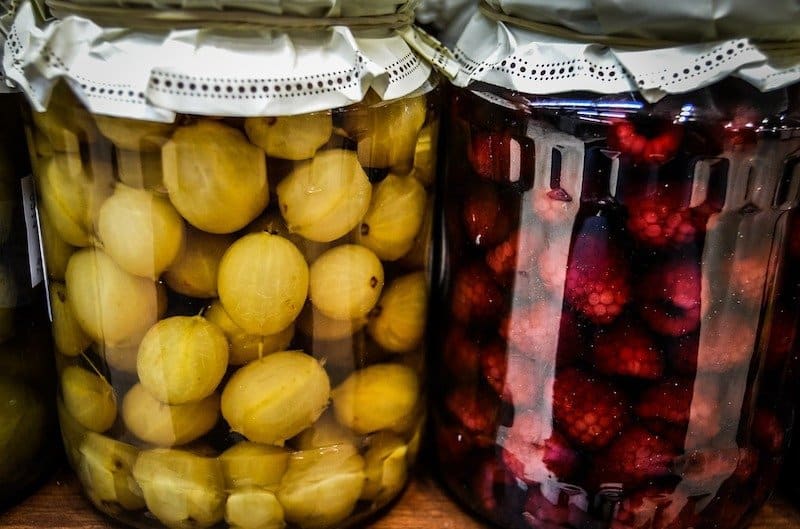How Does Fruit Ferment Naturally?
Fermenting fruit is very different from fermenting vegetables. It’s more common to find foods made from fermented vegetables, like sauerkraut or kimchi, because they have a lower sugar content. The high sugar content in fruits allows them to quickly create alcohol during the fermentation process, which is why it’s more common to find fruit in alcohol ferments like wine and cider.
That being said, there are many good reasons to ferment fruits, and the process isn’t complicated. So how does fruit ferment naturally? Here’s everything you need to know.
How Fruit Ferments Naturally
Fermentation is the process where, deprived of oxygen, certain bacteria and yeasts consume the sugars in foods and create new flavor compounds. These beneficial microorganisms are found naturally in all kinds of foods, and fermentation creates the right environment for them to grow and thrive.
When you ferment vegetables, beneficial probiotic bacteria (particularly the lactobacillus bacteria) feed on the vegetable’s sugars and create a flavorful, sour, acidic environment that discourages any other bacteria.
When you ferment fruit, the sugars are so plentiful and easily accessible that they are more commonly consumed by yeasts rather than bacteria. When yeast begins to grow in an environment, it consumes sugar and creates alcohol. Also, honey, which also has a high sugar content, is often fermented with yeast to make mead.
This is why fruits (like grapes, apples, and even bananas – yep, click here to learn more) are usually fermented for alcohol, and vegetables are traditionally fermented for food. It’s also why many fruits will naturally ferment by themselves. It’s not uncommon for fallen apples to ferment, leading to those viral videos of squirrels and other animals who have gotten “drunk” from eating old apples.
Fermenting Fruit FAQs
Can Fruit Ferment in the Fridge?
Because the bacteria and yeasts that cause fermentation are already present on fruit, in the air, and on your household surfaces, yes, fruit can sometimes ferment in the refrigerator. Most of the time, this happens by accident. Fermentation happens more easily and more quickly when you create a beneficial environment, and the fridge is not the ideal environment for yeasts and microorganisms to grow. Because most fruits also have skins that keep surface microorganisms from accessing the sugar inside, it is most common when fruits have been mildly crushed or torn or have been peeled and then left in the refrigerator for a while.

How to Ferment Fruit Quickly
Fruit ferments more quickly than vegetables because it’s high in sugar. While fruits naturally have the bacteria and yeasts that start fermentation, these natural microorganisms can be unpredictable. If you want to ferment fruits quickly and have a more predictable outcome, it’s best to use a starter culture. The kind of starter you use helps your fruit ferment more rapidly but also determines whether you’ll end up with alcohol in your fermentation or not.
The fastest way to ferment fruit is with a lactobacillus fermentation, rather than with a yeast fermentation. This process will convert fruit sugars into lactic acid rather than alcohol. To quickly ferment fruit with the lacto fermentation process, follow these steps:
In a large jar, mix together:
- 2 tablespoons of a liquid sweetener, like honey, agave syrup, or maple syrup
- 2 tablespoons of a lactobacillus starter, such as whey, water kefir, sauerkraut juice, or a similar starter
- ¼ teaspoon salt
- 3 tablespoons of filtered water
- When well combined, set aside this mixture while you prepare the fruit
To prepare the fruit:
- Clean the outside of the fruit well
- Remove stems, leaves, and any blemishes. For fruits with an edible peel (like apples or peaches), you can leave the peel on if you prefer
- Chop or slice the fruit and pack it into a jar
- If you want, you can add spices for flavoring, such as cinnamon sticks, allspice berries, cardamom pods, citrus rinds, or flavoring extracts
- When the jar is packed, pour your starter liquid over the prepared fruit
- Add a weight to ensure that your fruit remains completely submerged
- If your starter liquid does not completely cover the fruit, add enough filtered water to cover the fruit
- Leave an inch of headspace at the top of the jar
- Seal the jar and place it away from direct sunlight at room temperature
- Following this method, your fruit may be fermented in as short as a couple of hours. The fruit can remain in the liquid for up to two days.
What Fruit Ferments the Fastest?
The fruits that ferment the quickest are high in sugar. Red and white grapes and peaches ferment the most quickly, creating alcohol in just 6 days. After that, it takes about 9 days for apples, pears, and pomegranates to ferment. Low sugar fruits like cranberries may not properly ferment at all, and the large number of seeds in blackberries can interfere with fermentation.
Can Fruit Ferment Without Yeast?
Yes, fruit can ferment without added yeast. In fact, most people who are fermenting fruit for food (and not alcohol) purposes will deliberately avoid yeast and instead use a different “starter” or other bacteria to begin the fermentation process. Fermenting fruit without yeast is one way to prevent it from becoming alcoholic, and it’s very common.
In Summary
If you want to ferment fruit to create alcohol, use a yeast-based starter to convert the fruit sugars into alcohol. If you want to enjoy the probiotic benefits of fermented foods, use a lactobacillus starter to ferment without creating alcohol.
Fruits ferment more quickly than vegetables and tend to not last as long, so they should be enjoyed soon after fermentation. Fermenting fruits allows you to enjoy incredible jams, chutneys, and other fascinating flavors while boosting your digestive health. Fermenting fruits is so fast and easy that it often happens naturally, so there’s no reason to not start experimenting with your own fermented fruits now!








